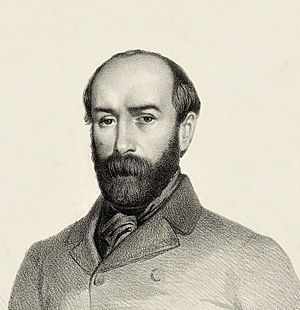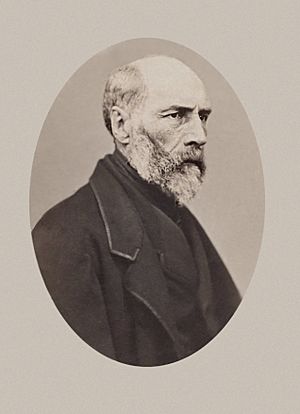Armand Barbès facts for kids
Quick facts for kids
Armand Barbès
|
|
|---|---|
 |
|
| Born | 18 September 1809 |
| Died | 26 June 1870 (aged 60) |
| Known for |
|
Armand Barbès (September 18, 1809 – June 26, 1870) was a French revolutionary. He believed in a republic, where people elect their leaders. He strongly opposed the July monarchy, which was the king's rule in France from 1830 to 1848.
His life is often remembered for two important days:
- May 12, 1839: On this day, Barbès led an uprising. Republicans tried to overthrow King Louis Philippe. His actions led to him being sentenced to life imprisonment. However, he was set free by the revolution of 1848.
- May 15, 1848: Demonstrators entered the Assemblée Nationale. Barbès had been a deputy there for only about three weeks. The protesters wanted the government to help free Poland. Things got out of control. Barbès became involved in what was seen as an attempt to take over the government.
Barbès was sent to prison again. But he was pardoned by Napoleon III in 1854. He then moved to the Netherlands. He died there on June 26, 1870. This was just weeks before the end of the Second Empire in France.
He was sometimes called the Bayard of Democracy. This was likely in honor of the brave knight Pierre Terrail, seigneur de Bayard.
Contents
Early Life and Beliefs
Barbès was born into a middle-class family. This happened in Pointe-à-Pitre, Guadeloupe. His father was an army surgeon from Carcassonne, France. He had fought in Napoleon's Egyptian campaign. The family returned to Carcassonne in 1814.
In 1830, at age twenty, Armand arrived in Carcassonne. He was already interested in republican ideas. He was strong and smart. He was chosen to lead the local National Guard. His father paid for this group himself.
The next year, Armand went to Paris. He planned to study medicine. But he found the sight of blood difficult. So, he decided to study law instead. Barbès lost his parents when he was young. He inherited a lot of money. This meant he did not need to work. He could focus on his main goal: trying to overthrow the government.
Joining Revolutionary Groups
In 1834, Barbès joined a group called the Société des Droits de l'Homme (Society for the Rights of Man). This group was similar to the Jacobins from the French Revolution. This led to his first arrest. He was released in early 1835. He then worked as a lawyer for 164 people. These people were accused of republican rebellion in 1834. In July 1835, he helped 28 of them escape from Sainte-Pelagie prison in Paris. This prison was for political prisoners.
In 1834, the police broke up the Society for the Rights of Man. Barbès then started a new group called the Society of Avengers. After that, he formed the League of Families. For this group, Barbès wrote the oath that all new members had to take. This was the start of his long connection with Louis Auguste Blanqui.
On March 10, 1836, Barbès and Blanqui were arrested. They were loading ammunition in their Paris apartment. Barbès was sentenced to one year in prison. He was pardoned in 1837. He then spent several months with his family in Carcassonne. There, he planned a new secret society. He also wrote a brochure. It was called "A Few Words to Those who Sympathize with Workers without Work". This was his only written work about revolution.
When he returned to Paris in 1838, he joined Blanqui and Martin Bernard (politician). Together, they formed another secret republican group. It was called the Society of Seasons.
The Society of Seasons and the 1839 Uprising
The Society of Seasons was organized in a special way. A "week" had six men and a leader. Four "weeks" made a "month" of 28 members plus a leader. Three "months" made a "season." Four "seasons" made a "year." At its peak, the Society had more than three "years" of members.
The Society of Seasons led to the uprising on May 12, 1839. Barbès led this event. The Society had about 900 members. They felt strong enough to try to take over Paris. Four hundred rebels managed to capture the National Assembly, the city hall, and the Palace of Justice. But they could not hold these places for long. They did not have enough people or weapons.
After this uprising failed, Barbès was sentenced to death. But his sentence was changed to 'life imprisonment'. This was largely because Victor Hugo spoke up for him. These events also caused a disagreement between Barbès and Blanqui. This disagreement made it harder for the extreme left-wing groups to work together in 1848 and later.
Barbès was sent to Mont-Saint-Michel prison on July 17, 1839. He was with three other prisoners, including Martin Bernard. Bernard wrote a detailed account of their time in prison. Barbès and others tried to escape on February 10 and 11, 1842. They used a rope made of knotted sheets. Barbès was the first over the wall. But he was hurt when he fell. This stopped the escape attempt.
Barbès and Blanqui's Rivalry
Blanqui was a main leader of the 1839 uprising. He seemed to think Barbès was not strong enough. He believed Barbès was tired from many setbacks. Blanqui thought this attitude discouraged other rebels. He felt it led to the uprising's failure.
When Barbès was released from prison in 1848, he seemed to have new energy. He brought together the revolutionary left. He guided them in a more moderate direction. He wanted to oppose Blanqui. With help from Alphonse de Lamartine, Barbès formed the Club of the Revolution. This was to work against Blanqui's Central Insurrection Society. Blanqui later wisely renamed his group the Central Republican Society.
Barbès had some military experience from his youth. So, he was made a colonel in the National Guard. On April 16, 1848, he led his troops against a workers' protest. This protest was led by Louis Blanc and Blanqui. The workers wanted more social programs. They especially wanted to delay the upcoming elections. They believed the government had not had enough time to "educate" people outside Paris. They thought the new Assembly would be controlled by conservatives.
In March 1848, the bad feelings between Barbès and Blanqui grew. A document called the document Taschereau was published. It claimed to be from police records. It supposedly proved that Blanqui had betrayed his fellow rebels in 1839. Many historians now think this document was likely fake. It might have been spread by the government to cause problems. If so, it worked. Barbès seemed to believe the document was real. This caused "terrible divisions" among left-wing groups. These divisions lasted for many years.
The two men became very distrustful of each other. They ended up hating each other. Yet, both are seen as important figures in French republican history. They are known as strong revolutionaries. Barbès was perhaps more thoughtful than Blanqui. He was fascinated by Blanqui, who was romantic and brave, but also impulsive. Barbès hoped to guide Blanqui's powerful energy. But many believe he was secretly afraid of Blanqui's unpredictable and violent side.
The Events of May 15, 1848
After being released from prison in 1848, Barbès seemed focused on stopping Blanqui. He was elected to the Constituent Assembly on April 23, 1848. He represented his home area of Aude. But his time in parliament was short. On May 15, demonstrators entered the Assembly. They claimed to be presenting a petition to help free Poland.
Barbès first opposed the demonstration. He tried to make the crowd leave. But he seemed to lose control when he saw Auguste Blanqui in the Assembly. In an effort to use the demonstration against his enemy, he caused a riot. This happened in front of the city hall. A new, more radical republic was announced there. The uprising stopped when the National Guard arrived. Barbès was sentenced to life imprisonment in April 1849. He was found guilty of trying to overthrow the government and causing a civil war.
Later, Barbès showed great courage and honor. He was willing to sacrifice himself. This explains his strong appeal to others. This view was shared by everyone who knew him. There was also a part of him that was hard to understand. This "myth of Barbès" continues to interest people.
Barbès was released from prison by Napoleon III in 1854. However, he never went back to France. He had spent almost 15 years in prison as a political prisoner. He realized that returning to France might tempt him to get involved in politics again. So, he chose to live in exile in The Hague, Netherlands. He died there on June 26, 1870, at age 60. This was just weeks before the Second Empire fell. This event would surely have made him very happy.
He is buried on private land in Fourtou at Villalier, Aude.
See Also
 In Spanish: Armand Barbès para niños
In Spanish: Armand Barbès para niños
- Barbès – Rochechouart (Paris Métro)
- Ferdinand Barrot
- Château de Vincennes
- French demonstration of 15 May 1848
- Albert Laponneraye
- Étienne-Denis Pasquier
- Listing of the works of Alexandre Falguière


